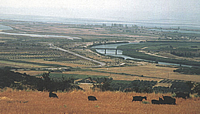THE HOLY MONASTERY OF THE ALL-HOLY VIRGIN OF THE ACHEIROPOIITOU - THE "KOSINITZA"
Tradition has it that the Monastery of the Kosinitza, or Eikosifoinissa, one of the most important monastic complexes in Northern Greece, was founded in 450 with the help of Sozon, Bishop of Philippi between 443 and 454 AD. However, it is the Blessed Germanos who is credited with having founded the monastery in 518 AD; while Dionysios, the Ecumenical Patriarch between 1466 and 1471 and again between 1488 and 1490, is commemorated as its second founder due to the central role is commemorated as its second founder due to the central role he played in augmenting the holy institution's importance by going into retreat in the monastery in 1471 after his first stint as Patriarch, and withdrawing there once again in 1490 and remaining there until his death in 1492. He was declared a saint of the Orthodox Church, and the Monastery of Kosinitza - where his remains are kept - celebrates his memory on November 23. The fathers concern for the nation, coupled with the monastery's substantial income from donations, allowed the monastery of the Virgin Acheiropoiitou to run a school teaching basic literacy until 1834. The monastery was burnt to the ground in 1507, and it wasn't until 1770 that it had regained its former glory. The monastery played a pivotal role in the events leading up to the 1821 revolution, and between 1805 and 1834, its abbots were key players in the struggle for freedom. It was here that Emmanuel Papas swore in his men, and here that Grigorios V, the Ecumenical Patriarch, went into retreat. It was here that Mara - of Kantakouzinos stock, daughter of the Serbian leader, Georgios Brankovic, and wife of Murat II - was buried in 1487. The monastery's priceless library was stolen by the Bulgarians in 1917, before they torched its church. Parts of the marble rood screen have survived, along with the wooden rood screen which was made by craftsmen from Chios between 1781 and 1803, and the monastery's catholikon, which was completed in 1847 and is an extension of the original church which dates from 1387. The monastery is situated on the north-eastern slopes of Mount Paggaio, to the right of the road leading from Serres to Kavala.
AMPHIPOLIS
The city of Amphipolis was founded in 437 or 436 BC by Athenian colonists led by Agnonas, on a site which was - according to Thucydides - easily visible from both land and sea. The city controlled access to the inland forests and the gold mines at Paggaio, and quickly grew into the area's main commercial centre. As such, the city acquired great political significance for the Athenians, although relations between the two cities were not of the best. It was in 422 BC, during the Peleponnesian War, that Cleon and Brasidas, generals of Athens and Sparta respectively, lost their lives in front of the city's walls.
The city was protected by impressive walls, some 7.5 kilometres in length, while the acropolis was surrounded by a separate wall 2.2.kilometres long.The city submitted to the Macedonians in 359 BC, and was destroyed by the Thracians in the First Century BC.Amphipolis was a major trading centre during Roman times. Saint Paul visited the city (Acts 17.1), and the city was the seat of a bishopric which came under the authority of the Metropolitan of Thessaloniki.Slavic raids gradually disrupted trade and forced the population of the city to move elsewhere. A small village known by the name of Marmario grew up in Byzantine times on the site of the once-booming city, and after the area's conquest by the Turks in 1382-83, Byzantine Marmario came to be referred to in historical sources as Geni Kioi ("New Village").Visitors to the archaeological site of Amphipolis can now wander around the ruins of four basilicas, the floors of which are richly decorated with marble and exceptionally crafted mosaics. These churches, along with the site's main monument, the remains of a Sixth Century pericentric church, are a clear testament to the prosperity Amphipolis enjoyed during the Christian era; while the temples of Atti and the nymph, Cleio, are indicative of its glory during its years as an autonomous city state.
Two towers, which were used to store agricultural produce in times gone by, are visible from the acropolis. The tower nearest to Amphipolis, which also commands the bridge over the River Strymona, was built by Alexios and Ioannou, the masters of the Athonite monastery of the Pantokrator, in 1367. There is also a large marble lion a short distance outside the ancient city. The statue is 5.37 metres in height, and is believed by researchers to be a work of the Fourth Century BC in honour of Laomedontas, the admiral of Alexander the Great's fleet, who was born in Amphipolis. The Amphipolis archaeological museum has a number of inscriptions and coins on display, as well as rare finds from every stage of the city's history.
THE STRYMONA ESTUARY
The Strymona Estuary is made up of a number of salt-water lagoons and swamps, and is remarkable for the number of ecosystems to be found there.To date, the estuary's ecosystems have not suffered at the hands of man. The river still provides refuge for many species of fish, while the estuary is an important breeding ground and winter refuge for numerous species of birds, such as the Ciconia ciconia (the white stork), the Himantopus himantopus (the black-winged stilt), and the Haliaeetus albicilla (the White-tailed Eagle).
Writers:
Konstantinos Vavalekas
Haralampos Vouroutzidis

